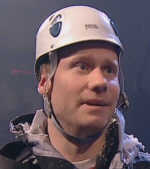Royal Institution Christmas Lectures 2007
Grilling and Chilling
Surviving Extreme Temperatures

Two young men set out to climb a mountain in January 1999. They were on the north face, nearing the summit when a massive storm blew up, trapping them on the summit ridge which was little wider than a tea tray. Day after day, they were pinned down, until on the sixth day a helicopter was able to reach them. Sadly, by then, one of them had died. The remaining one, Jamie Andrew, survived. The temperatures on the mountain were -30°C with 130Km/h wind speeds. He may have survives, but he lost both hands and feet to frostbite. Jamie was able to survive because he was able to keep his body temperature, near enough, to the right point. We need to know why that's important.
Chemical Slowdown
It's important because we are all chemical machines. Every single on of out 100 trillion cells is performing thousands of chemical reactions, and the speed of those reactions depends, very much, upon the temperature. Snakes and other reptiles can't keep their temperature constant. A snake exposed to cold is slow and sluggish. We need to keep our temperature much more constant.
How is it that we keep our temperature constant?
Firstly, we need to create heat. Our bodies naturally produce heat. Sitting at rest, our bodies produce about 100W of energy and 75% of that comes out as heat When we exercise we produce much more. A top athlete can produce nearly 1200W.
To keep our temperature constant we need to lose heat at the same rate as we are producing it. We can do that in a number of different ways. Heat radiates out from our body and, in the UK climate, we lose about 65% of our heat this way.
Different substances conduct heat to differing degrees, which is why a steel rod feels colder than a wooden rod. It is also why water feels cooler than the surrounding air even when it is a few degrees warmer. Being immersed in cold water will cool you rapidly as heat is being drawn away very quickly.
Mass movement of air is known as convection. The faster the air moves the more heat is drawn away and makes th temperature feel lower than it actually is. This phenomenon is known as wind-chill and it can make the apparent temperature many degrees lower than the ambient temperature.

Jamie Andrew
So, when Jamie Andrew was trapped in temperatures of -30°C, the wind-chill of a 130 km/h wind made the apparent temperature nearer -85°C.
Your breath is hot, you see it steaming in cold air. You're losing a lot of heat through your airways and lungs. The amount of heat you lose will depend on the airflow and the surface area of your lungs and airways. You may be surprised by how big that area is! A pair of adult lungs has a surface area of 80 sq metres, the area of a badminton court.
So, for climbers like Jamie to survive, he's got to try and minimise that heat loss. Climbers wear lots of layers of insulating clothing including special boots also made of multiple layers of insulation.
Despite all these protective layers of clothing, if he starts cooling, this is when the body's own defence mechanism starts to kick in. The first thing he does is to start generating heat. He starts to shiver which can double your body's heat production. If that doesn't work, your body has to try and get rid of the heat losses.

Frostbite
When you get cold, vasoconstriction shuts down the surface blood vessels, diverting the blood flow beneath the insulating layers of fat. This happens, mostly, at the periphery, so you sacrifice your limbs to keep your heart, brain and other organs alive. Sometimes, however, this isn't enough, as you continue to cool, your metabolism falls by about 6% for every degree. By the time you get to 28°C your metabolism is halved and that stops your brain cells working and your heart starts to beat irregularly.
When hands and feet are frozen, the tissue dies and inevitably leads to amputation being necessary.
Extreme Heat
The hottest place on the Earth's surface is the Libyan desert that comes in at a staggering 58°C. Bear in mind that your body temperature is around 37°C. If your body temperature rises to 42°C you die. Could someone survive standing in the Libyan desert?
Mac, the assistant is asked to swallow a radio thermometer to measure his core temperature, before being placed in a hot room at 58°C.
What happens if the air is hotter than you are? Conduction, convection and radiation are not taking heat away from you, they're delivering it to you. There is, however, one important cooling mechanism.
Evaporating water takes a lot of heat. It takes about one calorie for every 1˝ml you evaporate. To stay cool on a hot day, your sweat glands produce a salty water which lies on you like a film and evaporates. There are somewhere in the region of 2.6 million sweat glands on the human body.
There are limits to the cooling of sweat evaporation. If the air is moist and humid it can't absorb the sweat. The other problem is fluid loss. On a hot day you can lose 2 litres of water an hour, but your gut can only absorb 1˝ litres of an hour from drinking.
Finally, we check on Mac. He is hot and sweaty, but otherwise fine and his body temperature has only risen by a few tenths of a degree, Perspiration has kept him cool.

